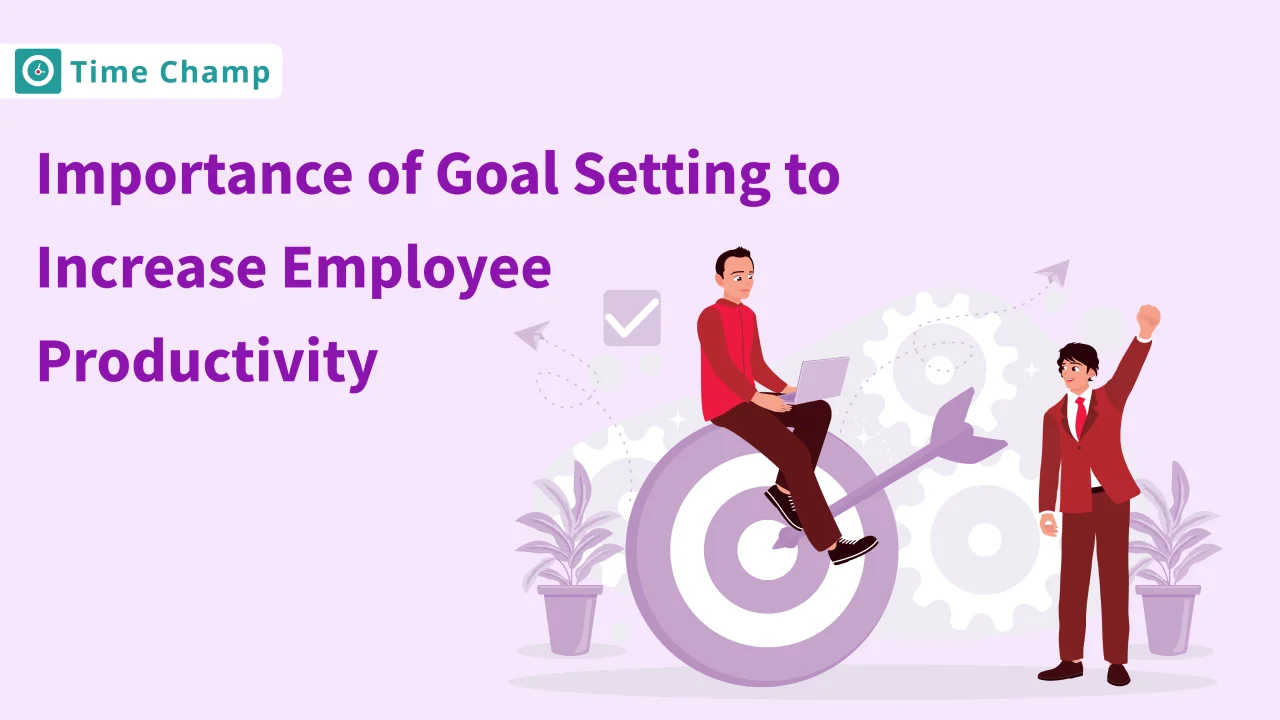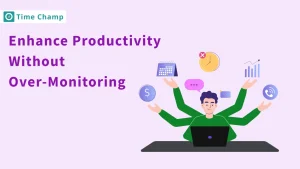In the Technological era where everyone is running behind success, one must not forget about the importance of goal setting. Goal setting for employees is crucial to set realistic goals that the employee can achieve within the given deadline.
A great plan and goal are the fundamental aspects of achieving company success, this can be done only when the goals are set according to the skills and talents of the employees and staff.
Many companies fail to set better goals as a result they fail to achieve success.
What is Goal Setting?
Goal setting means creating clear and doable targets for individuals or teams. It’s a way to motivate employees by helping them understand business goals and encouraging them to address and overcome challenges.
Importance of Goal setting for employees
1. Provides Direction and Purpose
Goal-setting gives employees an understanding of where they are going and helps them with the feeling of purpose in their work. When people have a specific understanding of what they need to achieve, they can work towards their goal by orienting their efforts in such a way as to carry out activities that bring their objectives closer it doesn’t matter whether it’s gaining a new skill, finishing a project, or reaching a career milestone, goals give employees a path to success.
2. Motivates and Inspires Action
Goals are very powerful motivators that move an employee towards productivity to act and seek for their success. When people have ambitious yet achievable goals to aim for, they are much more likely to feel energetic, engaged, and also committed to delivering their best. The aim of goals fuels an employee’s passion and gives him/her the courage to face challenges and take advantage of opportunities for development and growth.
3. Fosters Accountability and responsibility
Goal setting is important because it encourages a culture of accountability and ownership among employees. When individuals take ownership of their goals, they become personally invested in their success and are more likely to hold themselves accountable for their actions and outcomes. By taking responsibility for their performance and progress towards their goals, employees express a commitment to continuous improvement in their performance and contribute to the overall success of the organization.
4. Enhances Focus and Productivity:
Goals help employees in organizing tasks optimizing time management, and staying focused on activities that matter most. With clear goals in place, individuals can avoid distractions and procrastination, allowing them to maximize their productivity and efficiency. By maintaining a laser-like focus on their goals, employees can make steady progress towards achieving their objectives and delivering exceptional results in their roles.
5. Encourages Learning and Growth
Goal setting encourages employees to pursue ongoing learning and growth opportunities. Whether it’s learning new skills, looking out for challenging assignments, or pursuing professional development opportunities, goals motivate individuals to expand their knowledge and capabilities. By adopting a growth mindset and continuously aiming to improve, employees position themselves for long-term success and advancement in their careers.
Effective ways to set goals for your employees
1. Prepare a Plan:
Firstly, prepare a plan for what you want your company to achieve because a proper plan will give your employees proper guidance on what needs to be done to achieve the desired goal and then try to implement that plan with the required skilled and talented people.
2. Set specific and clear goals:
Setting clear goals for employees is essential for effective performance management and the success of an organization. These specific objectives provide clarity and guidance, ensuring that employees understand exactly what is expected of them and how their work contributes to the organization’s overall goals.
By properly setting the desired outcomes, milestones, and performance standards for each goal, employees can concentrate on their efforts, schedule their tasks, and utilize their resources effectively. They help Managers to monitor and accurately evaluate employee performance and to give focused feedback and guidance. Ultimately, clear goals empower employees to work with purpose, which boosts motivation, engagement, and productivity across the organization.
3. Set Relevant goals:
Setting relevant goals is crucial for employees to stay focused and motivated. These goals should directly relate to their roles and responsibilities within the organization, aligning with larger objectives.
When objectives are relevant, employees can recognize the link between their tasks and the overall prosperity of the company, thereby enhancing their sense of purpose and dedication. Additionally, relevant goals ensure that employees are working on tasks that contribute meaningfully to their personal growth and professional development.
By setting goals that are relevant to their job roles and career aspirations, employees are more likely to stay engaged, perform at their best, and achieve success in their roles.
4. Set measurable and attainable goals:
Setting goals that are measurable and attainable allows employees to track their progress effectively and stay motivated, leading to greater success. By establishing clear benchmarks and ensuring that goals are within reach, employees can maintain focus and confidence as they work towards achievement.
5. Set Time-bound goals:
Establishing time-bound goals is crucial for creating a framework and holding oneself accountable for reaching targets. When specific deadlines or timeframes are set for goals, employees feel driven to operate efficiently and productively within these time limits.
This practice discourages procrastination, creates a sense of urgency, and makes it easier to monitor progress towards completing goals. Furthermore, time-bound goals aid in prioritizing tasks and resources effectively, ensuring efforts are directed towards achieving desired outcomes within the allotted time.
Ultimately, this approach promotes productivity, improves performance, and promotes successful goal achievement.
6 amazing Benefits of employee goal-setting
- Clarity and Direction: Employee goal setting provides clear direction, ensuring everyone knows what they need to accomplish and how it contributes to the company’s objectives. And also fosters accountability and encourages employees to take responsibility for their performance and outcomes.
- Performance Improvement: Setting goals provides a framework for performance improvement, enabling employees to track their progress, identify areas for growth, and continuously enhance their skills and capabilities.
- Improved collaboration: Goal setting encourages communication and teamwork among team members, nurturing an environment where individuals collaborate towards common goals and achievements.
- Skill Development: Goals offer opportunities for skill development and career growth, motivating employees to stretch their capabilities, seek out learning opportunities, and advance their careers.
- Job Satisfaction: Clear goals aligned with personal interests and aspirations contribute to higher job satisfaction, reducing turnover and retaining valuable talent within the organization.
- Organizational Achievement: In the end, employee goal setting contributes to the success of the organization by aligning individual objectives with strategic goals, and nurturing a culture of excellence, innovation, and ongoing enhancement.
Types of Employee Goal-Setting
1. SMART Goal setting
Ensure that you have SMART Goals which means Specific, Measurable, Achievable, Relevant and Timely bound. The clear-cut specific goals outline the objectives that are to be accomplished, measurable goals define how success will be measured, achievable goals are realistic and doable, relevant goals are aligned with job responsibilities and organizational objectives, and time-bound goals have a deadline or time frame for completion.
2. OKR Goal Setting
Objectives and Key Results is a goal-setting formula that has gained popularity in many organizations, particularly in the tech industry, for its ability to align individual and team objectives with general organizational goals.
Example:
Objective: Improve Product Quality
Key Results:
- Reduce product defects by 25%.
- Increase customer satisfaction ratings from 4.2 to 4.5 out of 5.
- Achieve a 90% pass rate in product quality audits.
3. MBO Goal Setting
Management by Objectives (MBO) is a goal-setting approach designed to synchronize individual and team goals with organizational objectives. It stresses the significance of defining precise and quantifiable objectives, setting performance benchmarks, and consistently assessing advancement towards accomplishing those objectives. Time Champ can help you upgrade your goal-setting plan to a new level.
With the help of Time Champ, you can monitor the productivity of your employees and analyze their capabilities this helps you get an idea of how long it will take for a particular employee to complete a certain task.
Example:
Key Results:
- Close 20 new deals each month.
- Achieve a 25% increase in average deal size.
- Improve customer retention rate by 10%.
What is Time Champ?
Time Champ is an employee monitoring and productivity tracking software which helps businesses track and monitor the activities of their employees and obtain real-time information about any employee or team working on a specific project.
Signup now and discover all the best benefits of our employee productivity monitoring features
Time Champ Helps to Foster a Better Employee Goal-Setting
Time Champ understands the importance of goal setting to improve employee productivity and achieve desired organisational goals.
Time Champ provides the best suitable information for insights required for better goal planning. Time Champ tracks every activity of the employee including every website visited and every link clicked.
Time Champ provides a detailed productivity report on every employee categorized into productive time, non-productive time, and neutral time, it helps employers to analyze how the employee is using his working time. So that the employer can tailor the goals according to the capabilities and talents of their employees to complete a certain goal in a given time.
Key Features of Time Champ
Task Management:
Task Management Tracks employees working hours significantly for the particular task that how much time they’ve spent on it and how many tasks they’ve done in a day. You can schedule tasks easily and get notifications timely on the tasks assigned to your employees so that you can set the task deadline accordingly. This feature will be of great help in monitoring already assigned tasks and analyzing the status of the given task.
Project Management:
Using this Project Management feature you can assign tasks or projects to employees easily with project management. With this help, you can get goal management, project dashboards, bug tracking, sprint management, calendar view, and resource allocation. This feature will be of great help in organizing and assigning tasks based on employee skills.
Employee Productivity:
The Employee Productivity feature helps a lot in monitoring and tracking the employee’s working status and the level of productivity obtained from a particular employee. All the details related to an employee are displayed such as productive time, non-productive time, and neutral time along with all the applications and websites opened and time spent on each application by the employee during the working shift.
Employee Monitoring:
With the help of the Employee Monitoring feature you can Monitor the employee live screen, get screenshots and screen recording seamlessly as per your requirement. Get access to every activity of your entire team or organization and make informed decisions. Always stay updated about your employee’s whereabouts.
Task Tracking:
Task Tracking helps to Track employees’ work hours significantly for a particular task how much time they’ve spent on it how many tasks they’ve done in a day, and how long they are taking to complete a specific task. Schedule tasks easily and get notifications timely.
Goal setting provides employees with a clear direction and purpose, helping them prioritize tasks and stay focused on achieving desired outcomes. When employees have well-defined goals, they are more motivated, engaged, and productive in their work.
Establishing goals provides employees with clear targets to pursue, fostering a sense of accountability and dedication. Witnessing advancements toward these objectives bolsters their confidence and drive, encouraging sustained efforts towards achieving success.
Aligning individual goals with organizational objectives ensures that employees’ efforts are directed towards activities that contribute to overall organizational success. This alignment fosters a sense of purpose and unity among employees, leading to increased collaboration and productivity.
Managers play a crucial role in supporting employees in goal setting by providing guidance, resources, and feedback. They should communicate clear expectations, offer coaching and mentoring, and recognize achievements to encourage progress towards goals.
SMART goals, characterized by being Specific, Measurable, Achievable, Relevant, and Time-bound, offer clarity, concentration, and responsibility. They facilitate progress tracking and adherence to objectives, aiding employees in setting feasible targets and efficiently prioritizing tasks.
Goal setting aligns individual and team efforts with strategic objectives, driving performance, innovation, and expansion. Collaboration, accountability, and ongoing improvement are supported as employees pursue shared goals, resulting in increased organizational success.






